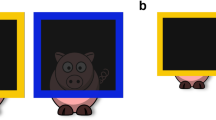Abstract
Observations were made of the personal space behaviors of same-sex pairs of children, aged 6–16. Results indicated that children used more space as they grew older and that adult proxemic behaviors were acquired by age 12. While in the younger children no sex differences were present for the proxemic behaviors of distance and body orientation, males were found by early adolescence to stand farther apart and at greater angles than females. The development of personal space and of sex differences in these behaviors is discussed in the context of social learning.
Similar content being viewed by others
References
Aiello, J. R. (1972). A test of equilibrium theory: Visual interaction in relation to orientation, distance and sex of interactants.Psychon. Sci. 27: 335–336.
Aiello, J. R. (1973). Gaze direction during interaction. Paper presented at the Eastern Psychological Association Convention, Washington, D.C., May.
Aiello, J. R., and Cooper, R. E. (1972). Use of personal space as a function of social affect. InProceedings of the 80th Annual Convetion. American Psychological Association, Washington, D.C., pp. 207–208.
Aiello, J. R., and Jones, S. E. (1971). A field study of the proxemic behavior of young school children in three subcultural groups.J. Personal. Soc. Psychol. 19: 351–356.
Argyle, M., and Dean, J. (1965). Eye contact, distance, and affiliation.Sociometry 28: 289–304.
Ashear, V., and Snortum, J. R. (1971). Eye contact in children as a function of age, sex, and social and intellectual variables.Develop. Psychol. 4: 479.
Bass, N., and Weinstein, M. (1971). Early development of interpersonal distance in children.Can. J. Behav. Sci. 3: 368–372.
Baxter, J. C. (1970). Interpersonal spacing in natural settings.Sociometry 33: 444–456.
Beck, R. (1970). Spatial meanings and the properties of the environment. In Proshansky, H., Ittelson, W., and Rivlin, L. (eds.),Environmental Psychology: Man and His Physical Setting, Holt, Rinehart and Winston, New York.
Bloom, R., Harvey, H., and Howells, G. (1973). The development of interpersonal distance in children and adolescents. Paper presented at the Western Psychological Association, Anaheim, California, April.
Booream, C. D., and Flowers, J. V. (1972). Reduction of anxiety and personal space as a function of assertion training with severely disturbed neuropsychiatrie inpatients.Psychol. Rep. 30: 923–929.
Carlson, R., and Price, M. A. (1966). The generality of social schemas.J. Personal. Soc. Psychol. 3: 589–592.
Estes, B. W., and Rush, D. (1971). Social schemas: A developmental study.J. Psychol. 78: 119–123.
Fischer, C. (1968). Social schemas: Response sets or perceptual meanings?J. Personal. Soc. Psychol. 10: 8–14.
Fry, A. M., and Willis, F. N. (1971). Invasion of personal space as function of the age of the invader.Psychol. Rec. 21: 385–389.
Goldberg, G. H., Keisler, C., and Collins, B. (1969). Visual behavior and face-to-face distance during interaction.Sociometry 32: 43–53.
Guardo, C. (1969). Personal space in children.Child Develop. 40: 143–151.
Hall, E. T. (1959).The Silent Language, Fawcett, Greenwich, Conn.
Hall, E. T. (1963). A system for the notation of proxemic behavior.Am. Anthropologist 65: 1003–1026.
Hall, E. T. (1966).The Hidden Dimension, Doubleday, New York.
Hobbs, N. (1966). Helping disturbed children: Psychological and ecological strategies.Am. Psychologist 21: 1105–1115.
Jones, S. E. (1971). A comparative proxemics analysis of dyadic interaction in selected subcultures of New York City.J. Soc. Psychol. 34: 35–44.
Jones, S. E., and Aiello, J. R. (1973). Proxemic behavior of black and white first, third, and fifth grade children.J. Personal. Soc. Psychol. 25: 21–27.
Katz, N. (1937).Animals and Men, Longmans, Green, New York.
Klopfer, P. H., and Hailman, J. P. (1967).An Introduction to Animal Behavior, Prentice-Hall, Englewood Cliffs, N.J.
Little, K. B. (1965). Personal space.J. Exptl. Soc. Psychol 1: 237–247.
Maccoby, E. E., and Jacklin, C. N. (1971). Sex differences and their implications for sex roles. Paper presented at the American Psychological Association Convention, Washington, D.C., September.
Maccoby, E. E., and Jacklin, C. N. (1973). Stress, activity, and proximity seeking: Sex differences in the year-old child.Child Develop. 44: 34–42.
McBride, G., King, H. G., and James, J. W. (1965). Social proximity effects on galvanic skin response in adult humans.J. Psychol. 61: 153–157.
Mehrabian, A. (1968). Relationship of attitudes to seated posture, orientation, and distance.J. Personal. Soc. Psychol. 10: 26–30.
Meisels, M., and Guardo, C. J. (1969). Development of personal space schemata.Child Develop. 40: 1167–1178.
Mueller, E. (1971). Origins of success and failure in children's spontaneous communication. InProceedings of the 79th Annual Convention, American Psychological Association, Washington, D.C., pp. 153–154.
Scheflen, A. E. (1965). Quasi-courtship behavior in psychotherapy.Psychiatry 28: 245–257.
Sommer, R. (1959). Studies in personal space.Sociometry 22: 247–260.
Sommer, R. (1969).Personal Space: The Behavioral Basis of Design, Prentice-Hall, Englewood Cliffs, N.J.
Tolor, A. (1968). Psychological distance in disturbed and normal children.Psychol. Rep. 23: 695–701.
Willis, N. (1966). Initial speaking distance as a function of the speakers' relationship.Psychon. Sci. 5: 221–222.
Winer, B. J. (1962).Statistical Principles in Experimental Design, McGraw-Hill, New York.
Author information
Authors and Affiliations
Additional information
This research was supported in part by NIMH Grant MH-10779-04 and a grant to J. R. A. from the Research Council of Rutgers University.
Rights and permissions
About this article
Cite this article
Aiello, J.R., De Carlo Aiello, T. The development of personal space: Proxemic behavior of children 6 through 16. Hum Ecol 2, 177–189 (1974). https://doi.org/10.1007/BF01531420
Received:
Revised:
Issue Date:
DOI: https://doi.org/10.1007/BF01531420




